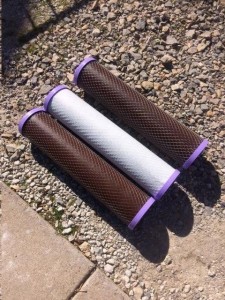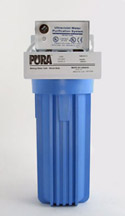
What Happens to All the Salt We Dump On the Roads?
In the U.S., road crews scatter about 137 pounds of salt per person annually to melt ice. Where does it go after that?
Editor's Note: This article is adapted from an article on road salt that appeared in a December 2014 Occasional. The original was indebted to an article by Joseph Stromberg from Smithsonian.com
Municipalities in many states rely on a crucial tool in clearing ice and snow from their roads: salt.
Because the freezing point of salty water is a lower temperature than pure water, scattering some salt on top of ice or snow can help accelerate the melting process, opening up the roads to traffic much sooner. It's estimated that more than 22 million tons of salt are scattered on the roads of the U.S. annually—about 137 pounds of salt for every American.
But all that salt has to go somewhere. After it dissolves—and is split into sodium and chloride ions—it gets carried away via runoff and deposited into both surface water (streams, lakes and rivers) and the groundwater under our feet.
Consider how easily salt can corrode your car. Unsurprisingly, it's also a problem for the surrounding environment—so much that in 2004, Canada categorized road salt as a toxin and placed new guidelines on its use. And as more and more of the U.S. becomes urbanized and suburbanized, and as a greater number of roads criss-cross the landscape, the mounting piles of salt we dump on them may be getting to be a bigger problem than ever.
Data from long-term studies of watersheds bear this out. A group of scientists that tracked salt levels from 1952 to 1998 in the Mohawk River in Upstate New York, for instance, found that concentrations of sodium and chloride increased by 130 and 243 percent, respectively, with road salting the primary reason as the surrounding area became more developed. Similarly, a study of a stream in southeastern New York State that was monitored from 1986 to 2005 found a similar pattern, with significant annual increases and road salting to blame for an estimated 91 percent of sodium chloride in the watershed.
Because it's transported more easily than sodium, chloride is the greater concern, and in total, an estimated 40 percent of the country's urban streams have chloride levels that exceed safe guidelines for aquatic life, largely because of road salt.
This chloride can occasionally impact human water use, mostly because some penetrates into the groundwater we tap for drinking purposes. Water utilities most frequently report complaints of salty drinking water during the winter, when chloride concentrations are likely to exceed 250 parts per million (ppm), our tastebuds' threshold for detecting it. This is an especially big issue for people on salt restrictive diets. Overall, though, road salt-laced drinking water isn't a widespread problem: A 2009 USGS study found that fewer than 2 percent of the drinking wells sampled had chloride levels that surpassed federal standards.
Road salt pollution is generally a bigger issue for the surrounding environment and the organisms that live in it. It's estimated that chloride concentrations above 800 ppm are harmful to most freshwater aquatic organisms—because these high levels interfere with how animals regulate the uptake of salt into their bodies—and for short periods after a snow melt, wetlands nearby highways can surpass these levels. A range of studies has found that chloride from road salt can negatively impact the survival rates of crustaceans, amphibians such as salamanders and frogs, fish, plants and other organisms. There's even some evidence that it could hasten invasions of non-native plant species—in one marsh by the Massachusetts Turnpike, a study found that it aided the spread of salt-tolerant invasives.
On a broader scale, elevated salt concentrations can reduce water circulation in lakes and ponds (because salt affects water's density), preventing oxygen from reaching bottom layers of water. It can also interfere with a body of water's natural chemistry, reducing the overall nutrient load. On a smaller scale, highly concentrated road salt can dehydrate and kill trees and plants growing next to roadways, creating desert conditions because the plants have so much more difficulty absorbing water. In some cases, dried salt crystals can attract deer and moose to busy roads, increasing their chance of becoming roadkill.
How can we avoid killing trees and making roadkill of deer while de-icing the roads? Recently, in some areas, transportation departments have begun pursuing strategies to reduce salt use. Salting before a storm, instead of after, can prevent snow and ice from binding to the asphalt, making the post-storm cleanup a little bit easier and allowing road crews to use less salt overall. Mixing the salt with slight amounts of water allows it to spread more, and blending in sand or gravel lets it to stick more easily and improve traction for cars.
While rock salt is the most affordable and commonly used chemical to de-ice roads, sand also may be used. Other chemicals are also available. Most of these other chemicals are more commonly used for sidewalks or driveways. Each chemical, including road salt, has pros and cons. One of the biggest advantages of rock salt is that it is readily available and inexpensive. However, it does not work under extremely cold conditions and it does pose significant environmental risks. The primary concern is that the sodium and chlorine get into the ground and water and raise the salinity. Also, because rock salt is impure, other undesirable compounds present as contaminants are released into the ecosystem. Examples of contaminants include lead, cadmium, chromium, iron, aluminum, manganese, and phosphorus. There is no "perfect" de-icer, so the goal is to use the best chemical for the situation and to use the lowest effective quantity.
Many municipalities are trying out alternate de-icing compounds. Over the past few years, beet juice, sugarcane molasses and cheese brine, among other substances, have been mixed in with salt to reduce the overall chloride load on the environment. These don't eliminate the need for conventional salt, but they could play a role in cutting down just how much we dump on the roads.
City Water: Take Nothing for Granted

The two discolored carbon block cartridges in the photo turned blood red with rust stains and clogged after only two months of service at a home served by a small municipal water supply in Texas. The cartridges are 4.5″ X 20″ carbon blocks that were installed in tandem, so that each got only half of the water flowing into the home. Use was moderate.
The condition of the filters underlines the lesson that we are learning from news from Flint, Michigan and the many other poor water quality stories that are surfacing involving city water systems. The lesson is that city water is not necessarily as safe as we have always assumed–that it isn’t, in fact, being monitored to assure that every drop that comes from the treatment plant is perfect and certainly that every drop that passes through our aging delivery pipes gets to us without contamination.
The logical place to treat water to assure its excellence for general household functions is at point of entry–where the water enters the home itself. Carbon filtration at point of entry and a high quality drinking water unit under the sink are becoming as common and as necessary as locks on the doors.

Ultraviolet treatment, once used almost exclusively on unchlorinated wells, is now becoming a common fixture in city homes as “boil water” alerts and disinfection failures become more common. UV provides a margin of safety even where water is chlorinated.
Current Water News
Scientists are going to map Yellowstone’s underground water. During the park’s closure before the winter season begins, researchers are flying a helicopter equipped with a 1400-pound hula-hoop-shaped electromagnetic apparatus over large swaths of Yellowstone to try to map what is happening below the surface.
If India’s prime minister, Narendra Modi, gets his way, work could soon begin on a project to link large rivers in the Himalayas and Deccan Peninsula via 30 mega-canals and 3000 dams.
When the work is finished the water network will be twice the length of the Nile, the world longest river, and it will be able to divert water from flood-prone areas to those vulnerable to drought.The project has been called the biggest engineering project ever. But geologists and ecologists in India question the science behind the Inter Linking of Rivers (ILR) scheme. If it goes ahead it might lead to ecological disasters and coastal erosion that would threaten livelihoods and endanger wildlife.
President-elect Donald Trump announced a bold plan to combat rising sea levels by damming all US rivers that flow into the sea. " You see, it's all very simple," Trump said. "When the bathtub is full, you don't keep putting water in it. When I get my dams in place, all the water we've been putting into the overfilled oceans will be available for farmers. Very simple."
A 46-year-old Fort Walton Beach woman was charged with theft of utilities after using 56,000 gallons of water from a foreclosed home where she was staying.
The water of six major rivers flowing around Dhaka is now so polluted that authorities have declared that their water is beyond treatment for use as drinking water.
A 100,000 gallon water storage tank in Keene, NH was drained when several dead field mice were discovered floating in the tank.
More of Earth’s surface is covered by liquid water now than three decades ago. But some countries in Central Asia and the Middle East have lost more than half their surface water, satellite images show. There have also been losses in the US and Australia. The changes are mainly a result of activities such as irrigation and dam building, but climate change is playing a part too.
Lubbock, TX, in search of more water, is studying the possiblility of tapping into a water source that lies far below the Ogallala Aquifer. It’s called the Dockum Aquifer, and right now the city is planning a test well that will extend about 1,500 feet below the surface to capture and test the brackish groundwater to determine if it’s a viable water source. For comparison, the Ogallala — a source of much of the area’s water — is 50-300 feet below the surface.
According to CBC News, in spite of standards imposed by the Conserative government 4 years ago, more than 205 billion litres of raw sewage and untreated waste water spewed into Canada's rivers and oceans last year. The amount of untreated waste water, which includes raw sewage and rain and snow runoff, that flowed into Canadian rivers and oceans last year would fill 82,255 Olympic-size swimming pools — an increase of 1.9 per cent over 2014.
San Jose, CA, has lost its title as the largest U.S. city that does not fluoridate its drinking water. Fluoridation was started this month on a partial basis. Retrofitting of the water plant to support fluoride dosing was paid for by donations from the Califorinia Dental Association Foundation and a group called Health Trust. Retrofitting the plant cost $6.2 million and the project will not cover the entirety of Santa Clara County until 2020.
Ending a lengthy protest, the U.S Army Corps of Engineers announced that it would not allow sections of the Dakota Access oil pipeline to be drilled under the Missouri River near tribal lands. The Army says it will look for alternate routes for pipeline.

Since 2011, drought and pestilence have killed more than 100 million trees in California. What does that mean for the fate of the world’s largest tree, the giant sequoia?
Giant sequoias, like all trees, play a central role in the hydrologic cycle. Storms drop rain and snow, which giant sequoias can chug to the tune of 800 gallons per day—more than any other tree. As the trees draw water out of the ground, the air surrounding the leaves draws water through the trees and, eventually, back into the atmosphere. That process, called transpiration, creates tension within the tree’s water columns. The drier the atmosphere and the less groundwater available, the higher the tension. Under extreme drought conditions, when that tension grows too high, those columns of water can snap like a rubber band. Gas bubbles form, creating an embolism that prevents the flow of water up the trunk. If this happens enough, a tree will shed its leaves and can, eventually, die.
And speaking of trees, the EPA reported that approximately 33 million live Christmas trees are sold in North America every year. Two percent of these are cut wild.
Hyponatremia, or Water Intoxication
Drinking too much water left a woman with a urinary tract infection seriously ill, and doctors said water intoxication can kill you. The case in point is a 59-year-old London woman who, in an attempt to “flush out her system,” drank water so copiously that she developed hyponatremia, also called water intoxication.
According to the Mayo Clinic:
Hyponatremia is a condition that occurs when the level of sodium in your blood is abnormally low. Sodium is an electrolyte, and it helps regulate the amount of water that’s in and around your cells.In hyponatremia, one or more factors — ranging from an underlying medical condition to drinking too much water during endurance sports — causes the sodium in your body to become diluted. When this happens, your body’s water levels rise, and your cells begin to swell. This swelling can cause many health problems, from mild to life-threatening.
Hyponatremia is marked by an abnormally low level of sodium in the blood. Sodium helps regulate the quantity of water in and around cells.
There is a death rate of nearly 30 percent for patients whose sodium level drops drastically below normal. The condition can involve vomiting and significant speech difficulties.
The treatment may require medication, but usually it can be corrected simply by restricting water intake. Recovery may take a week or longer.
“The old adage to ‘drink plenty of water’ should be approached with caution if you are not vomiting, or experiencing diarrhea, or excessive sweating,” advised one doctor. “Your thirst is often the best guide to gauge when you think you need to drink more water if you have no history of kidney disease.”
Other signs of water intoxication include headaches, nausea and vomiting, confusion, loss of energy and fatigue. The illness can cause the brain to swell, coma, seizures and death.
People with normal kidney function who sometimes develop water intoxication are endurance athletes who drink more water while exercising than their kidneys can excrete.
Although doctors commonly advise patients with many ailments to “drink plenty of fluids,” little evidence supports the recommendation. There are definitely both risks and benefits to increased fluid intake.
Acidic Water
Acidic water is, by definition, any water with a pH of less than 7.0.
Water that is low in pH can have undesirable effects on plumbing fixtures and piping. Green staining of fixtures is a common indication of acidic water. Copper pipe can be ruined by water low in pH.
Low pH is also an issue in water treatment. Sometimes it is necessary to raise the pH of acidic water in order for other treatment strategies to apply. For example, oxidizing iron to prepare it for filtration is difficult if the pH of the water is low, so raising the pH of the water is often the first step in removing iron from well water.
Almost all water treatment issues involve pH in some way. Water constituents change in nature as pH changes, so many treatments can be applied only if pH is within the desired range.
Although the sales strategy of a class of drinking water products called "ionizers" is based on raising the pH of acidic water, there is no evidence that drinking water low in pH has any negative effect on health. Taste, of course, can be an issue if the pH is very low.
Treating Acidic Water
Acidic water can be corrected by several water treatment strategies. A common treatment is injection of soda ash, and a more aggressive treatment is the injection of caustic soda (sodium hydroxide). This is usually accomplished by injecting a solution of the soda ash or caustic soda directly into the water pipe.
A second strategy is to run the water through a bed of calcite (the most common treatment mineral) or corosex. As the low pH water passes through the bed, the mineral dissolves into the water and raises its pH.
Calcite treatment raises the pH by adding calcium carbonate to the water. This has the sometimes undesirable effect of increasing the hardness of the water slightly. Calcite and corosex are most commonly used in backwashing filters, but calcite alone can be used with simple upflow filters if the water is reasonably clean. Calcite is also commonly used in cartridge form as a postfiltration treatment for undersink reverse osmosis units. RO lowers pH, and calcite filters are used to bring the pH back to neutral.
Go here for more information about calcite filters or soda ash feeders.
Although we anticipate howls of disaproval, Pure Water Gazette numerical wizard B.Sharper's Christmas classic, "The Number of Nights Before Christmas that "Twas:1," will not appear in this issue. But stop pouting. You can read it here on the Gazette's website.
Happy Holiday to all from Pure Water Products, the Pure Water Gazette, and the Pure Water Occasional.

Please visit our RO Parts Page for tanks and accessories. We also have dedicated parts pages for countertop water filters, undersink filters, and aeration equipment. We stock parts for everything we sell.
Thank you for reading. Please come back next week.
Places to Visit on Our Websites:
Garden Hose Filters. Don’t be the last on your block to own one. And don't forget that National Garden Hose Day is just around the corner.
Model 77: “The World’s Greatest $77 Water Filter”
|